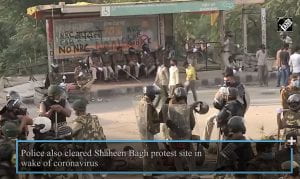Of late I have been winning big in the shouting matches with my dear father. The urge of the family patriarch to step out, if only on the pretext of clearing out the garbage, has been manifesting rather strongly after ten days or so of patient caution in the face of the lockdown declared in India to control the transmission of COVID-19. I must say that I am manning the gates rather well by delivering strongly worded, high decibel sermons, raining statistics at him, that gradually tone down his enthusiasm till he crumples in frustration and sinks into a sofa. I bask in the glory of my newfound authority, but that is short-lived. I don’t want to sound too dramatic, but I don’t really want to be a domestic version of Viktor Orban in my family. And there are other possible analogies to be wary of that are unfolding closer home.
The threat of COVID-19 was a convenient excuse to dislodge the numerous peaceful gatherings staged all over the country since the last few months to protest a new characteristically anti-Muslim citizenship law brought by the Hindu-nationalist regime helming the central government in India. These gatherings offered a mere symbolic presence in the face of the threat of infection. They went unspared nonetheless, and with little public notice, activists associated with the protest are now being arrested by the Indian state on charges of having provoked the recent “riots” in Delhi. These “riots” are by any measure better described as an organized and state-aided majoritarian reaction against the claiming of equal citizenship status by Indian Muslims through legitimate political means. Even as they have left hundreds homeless and languishing in crowded relief camps, the memory of the “riots” is now fading against the overwhelming attention garnered by COVID-19.

On the face of it, these actions of the Indian state could be quite indistinguishable from the general form of the lockdown. To make the lockdown a success, the formidable colonial legal heritage of India has been mobilised by the implementation of laws from over a century ago such as the Epidemic Diseases Act of 1897 and the Indian Telegraph Act of 1885 for constraining movement and congregations of citizens and conducting surveillance of quarantined individuals. Moreover, through invocation of the 2005 Disaster Management Act, the central government has, at least on paper, attempted an unprecedented takeover of the constitutional power of the states without declaring a formal emergency. Add to this a recent virtual gag order by the Supreme Court on the press in the name of controlling “fake news” and a police force swinging their batons at every moving thing that looks a little less than middle class, and you have almost the perfect arsenal for controlling diseases of all sorts, biological, social, political…
The government still has one more means of absolutely unparalleled efficacy with which to “control” this disease. Put simply: Let’s not test a lot of people for the virus. Knowledge is more burden than power. Our COVID-19 testing rates are amongst the absolute lowest in the world, and indicate that the ever-prescient ruling establishment in our country has already figured out the perils of using knowledge. Among the 600,000 odd migrant workers who migrated on foot back to their home towns and villages over the last week, about a third could easily have been infected, by the government’s own admission. Then again, why test them when we can simply lose sight of this risk? The method is time tested in India. Many deaths go unreported in this country every year. And why wouldn’t they? Given the two million odd malnutrition- and morbidity-related deaths that recur annually in India, there is some advantage to not keeping track.
I think we will win this. Or at least we would not know if we lost. But, back at home within the few hundred square feet of our familial confinement, it is difficult to be so certain. Here, I am negotiating on the wrong end of the Stalinist maxim of one death a tragedy, a million just a statistic. Maybe, just maybe, that could be done by getting off the statistical high horse and being a bit more reasonable. I could try that.
– 3 April 2020
Ritam Sengupta is finishing his Ph.D. in Social Sciences at the Centre for Studies in Social Sciences, Calcutta. He is based out of Kolkata, India. His doctoral project deals with the history of electrification in colonial and postcolonial India over the twentieth century that attempts to foreground transitions in energy regimes as one key to thinking the political and economic transformations in the region in this period. One part of the project, developed while undertaking a fellowship at the Max Planck Institute for the History of Science, concerns the history of the arrival of electricity to the northern Indian countryside as the energetic basis of irrigation from underground resources.
* * *
The Teach311 + COVID-19 Collective began in 2011 as a joint project of the Forum for the History of Science in Asia and the Society for the History of Technology Asia Network and is currently expanded in collaboration with the Max Planck Institute for the History of Science(Artifacts, Action, Knowledge) and Nanyang Technological University-Singapore.
![[Teach311 + COVID-19] Collective](https://blogs.ntu.edu.sg/teach311/files/2020/04/Banner.jpg)